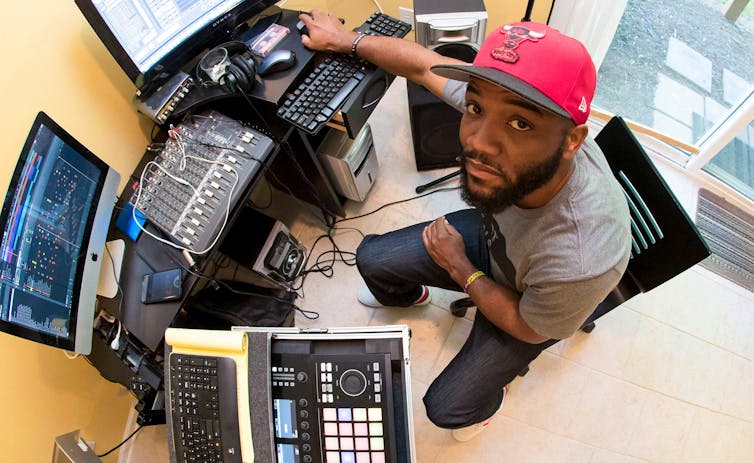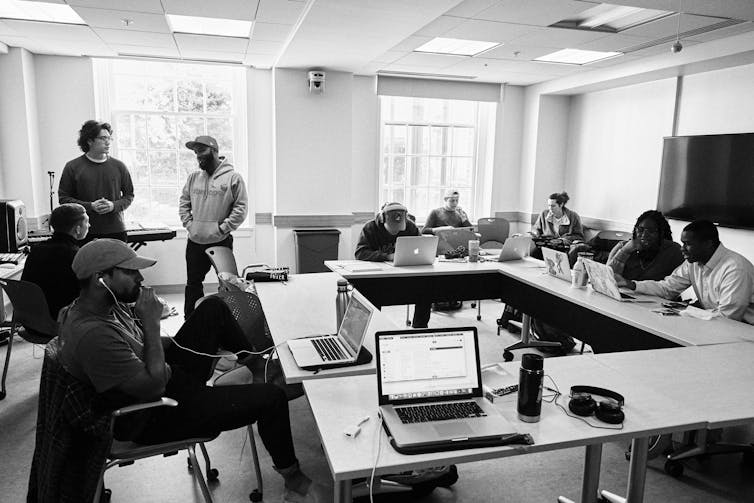32 Hip-hop Professor Looks to Open Doors with World’s First Peer-reviewed Rap Album
Learning Outcomes
- Apply the reading process to “Hip-hop Professor Looks to Open Doors with World’s First Peer-reviewed Rap Album.”
- Summarize the article.
- Respond to the article.
- Connect the ideas in the article to course offerings at your college.
Preview the Article
Follow the steps below to preview the article “Hip-hop Professor Looks to Open Doors with World’s First Peer-reviewed Rap Album.” Ideally, you should print the article and write your responses in the margins of the printed copy. To read more about previewing, visit the chapter on previewing a reading.
- Read the title. What does it make you think about? What do you think the article is about? What questions do you have? Record your predictions and questions on the printed copy of the article next to the title.
- Listen to a short, 5-minute interview with the author, AD Carson. What additional predictions do you now have about the article? What additional questions do you have? Record them on the printed copy of the article.
- Read the first three to five paragraphs. What additional predictions do you now have about the article? What additional questions do you have? Record them on the printed copy of the article.
- Scan the article and notice the headings (e.g. New methods) within the article. What additional thoughts or questions do these raise? Record them on the printed copy of the article.
- Notice the images and video used in the article. Read the captions and view the photos. What additional thoughts or questions does the video raise? Record them on the printed copy of the article.
- Scan the bolded and underlined vocabulary in the article. If there are any words that you do not know well, look them up in a print or online dictionary and write some notes about their meanings on the printed copy of the article. Keep in mind that some words have multiple meanings. You may need to read the sentence containing the word to understand the word’s usage. Additionally, some words and phrases, such as liner notes and peer-reviewed journal, may require a Google search to find out their meanings.
- Based on your preview of the article, what do you think is the central point of the article? (Don’t worry if you are not sure. This is a prediction or guess – you do not have to be correct as long as you are engaging your brain.) Record your prediction on the printed copy of the article.
- Based on your preview, do you predict that the article is narrative, expository, or argumentative?
Read Interactively
Now, read the article using the guidelines from the chapter on reading interactively. As you read, follow these steps to engage with the text.
- Pause to confirm or revise your predictions and to answer the questions you posed while previewing the article. Write down those revised predictions and responses to the questions as you read. If you cannot find the answers to your questions, save them for further research and discussion.
- Pause at other points to check for understanding of what you just read. Can you explain key ideas in your own words yet? If not, reread to clarify. Ideas that come later in a text build on the previous ones. Therefore, it makes no sense to keep reading if you did not understand something or if you became distracted. Anyone can become distracted while reading, so don’t hesitate to use the strategy of rereading when necessary.
- Pay attention to any vocabulary words that are confusing. Look up the words in a dictionary if they are interfering with your understanding, or mark them to return to later.
- Record any opinions or reactions you have to the reading in the margins of the article.
- Write down any further questions that develop as you read.
Hip-hop professor looks to open doors with world’s first peer-reviewed rap album

A.D. Carson, University of Virginia
March 16, 2021
1 As a rap artist who is also a professor of hip-hop, I always make it a point to have my songs reviewed by other artists I admire.
2 So when I released “i used to love to dream” – my latest album – in 2020, I turned to Phonte Coleman, one half of the trailblazing rap group Little Brother.
3 “Just listened to the album. S— is dope!” Phonte texted me after he checked it out. “Salute!”
4 I responded with sincere appreciation for his encouraging words. I told him they meant a lot to me, especially coming from him.
5 “Nah, bro. The bars are on point,” he replied. “Much love and respect.”
6 This informal conversation with a highly esteemed rapper – one whose work I’ve studied and hold in high regard – is perhaps the most resounding affirmation I can ask for as an artist.
7 The situation is similar in academia. That is, in order to establish oneself as a serious scholar, an academic must get their work – typically some sort of written product – published in a peer-reviewed journal, which is a journal in which works are evaluated by others in a given field to ensure their relevance and quality.
8 As a rap artist and academic, I wondered if I could do the same thing with my new album. Could I get my album “published” through an academic press?
9 Thankfully, I have discovered that the answer was “yes.” In August 2020, my album became what Michigan Publishing described as the “first ever peer-reviewed rap album published by a university press.” This is a development that I believe could open doors for scholars from all kinds of different backgrounds – including but not limited to hip-hop scholars – to contribute new forms of knowledge.
New methods
10 “With this new form of scholarship comes a new approach to the peer review and production process,” the University of Michigan Press stated in an article about my work.
11 But in order to get a peer-reviewed rap album, it’s not like I just went into the studio, rapped over some beats and hoped for the best. I presented liner notes and created a documentary about how I made the album, which I refer to as a “mixtap/e/ssay” – an amalgamation of the words “mixtape,” which is a sampling of an array of select songs, and “essay.” I also submitted articles that help explain how the music relates to certain academic conversations, events in society and my own life.

12 For instance, since the album is semi-autobiographical and I am from Decatur, Illinois, I note how in May 2020, my hometown was listed as America’s third-fastest shrinking city. Since my album deals with Black life, I note how USA Today ranked Decatur as one of “the 15 worst cities in America for Black people” in terms of various metrics, such as household income, educational attainment, homeownership, incarceration and life spans.
13 My album – which is free and open source – deals with topics that range from race and justice to identity and citizenship.
Confronting societal ills
14 In the lyrics, I reflect from where I am now – in my career as an assistant professor of hip-hop at the University of Virginia in Charlottesville – on my memories growing up and living in the central Illinois town.
15 The content of the album demonstrates this, covering issues like the war on drugs and its legacy in the 1980s and 1990s and contrasting it with the current opioid crisis on the song “crack, usa”; the seeming inevitability of police killings of Black people and how we might prepare ourselves and our loved ones on “just in case”; and the trap of incarceration and institutionalization presented on “nword gem.” It also provides space for processing mental health matters like trauma, alienation, alcoholism and depression with tracks like “ampersand,” “stage fright” and “asterisk.”
16 I published my album with University of Michigan Press because I believe it’s important that hip-hop – and hip-hop scholarship – occupies a space that’s not an “exotic other” and, instead, functions as a way of knowing, similar to, but distinct from, other resources such as a peer-reviewed paper or book.

17 In order to review my album as an academic work, the academic publisher had to “come up with appropriate questions for the evaluation of a sonic, rather than written, work.”
18 “The press’s standard peer review questions consider purpose, organization, and audience,” the University of Michigan Press has stated. “While many of those general themes were captured in the questions developed for ‘i used to love to dream,’ the process for coming up with new questions was much more collaborative.”
Is higher ed ready?
19 I must admit – both before and during my doctoral studies – I was skeptical of the formal peer-review process. My thought was, what is the university to ask hip-hop to prove itself?
20 But my skepticism faded once I saw the responses from the anonymous scholars who reviewed my album. Based on their insightful feedback, I got the sense that they truly understood Black music and Black rhetoric. They encouraged me to consider how to present the album online in a way that would help audiences better understand the content, which is part of the reason I included the short documentary about the making of the album.
21 This is not my first academic foray using rap. I actually earned my Ph.D. for writing a rap album.
22 I appreciate that hip-hop is sometimes celebrated in the academic world, but it seems to me that a lot of the excitement focuses on hip-hop as a particular kind of content rather than what it teaches people about other things in the world, many of which aren’t hip-hop.
23 For me, hip-hop is like a telescope, and the topics I discuss are like celestial bodies and galaxies. Taking that astronomical analogy a step farther, I would ask: Does it make sense to spend more time talking about the telescope that brought those faraway objects into focus and a sharper view? Or should more time be devoted to discussing the actual phenomena that the telescope enables people to see?
24 I can fully understand and appreciate how hip-hop – being not just a telescope but a powerful telescope – would generate a fair amount of discussion as a magnifier. At the same time, at some point society should be able to both focus on the potency of the lens of hip-hop and also concentrate on what hip-hop brings into view.
A.D. Carson, Assistant Professor of Hip-Hop, University of Virginia
This article is republished from The Conversation under a Creative Commons license. Read the original article.
Reflect
After reading the article, use the following questions to reflect on the content of the article and your reading process. See the chapter about reflecting for a discussion of why this is a crucial step.
- Try to paraphrase the main idea in a sentence. This may be challenging because you have read the article only once. If you are struggling, do your best. You can refine this when you reread and summarize the article.
- Is the article primarily narrative, expository, or argumentative? What is the purpose of the article? In other words, why do you think the author wrote it?
- Which predictions were accurate, and which did you have to revise?
- As you previewed the article, you wrote questions. What questions remain unanswered after reading the article?
- What else do you want to know about the article or topic of the reading? Write down any additional questions.
- How did previewing the article help you to understand and engage with the text while reading?
- Where did you struggle to understand something in the text, and how did you work through it?
- What, if anything, could you have done differently to improve your reading process?
Summarize
Complete a summary of the article by following these steps. Make sure you have read the chapters about Reading to Summarize before proceeding with the summary.
- Reread the article and complete the Summary Notes. See Preparing to Summarize for a review of this topic and an example.
- Then, use your Summary Notes to write a one-paragraph summary of the article. See Writing a Summary for a review of this topic and an example. Make sure that you include in-text citations and the Work Cited.
- Use the self-assessment/peer review questions from Evaluating a Summary to self-assess your summary or invite a peer to provide feedback.
- Use the self-assessment or peer feedback to make changes to your summary.
Make sure you are comfortable with your summary before advancing to the response. If you misunderstand something in the article, then your response may be skewed based on that misunderstanding.
Respond
Write a response to the article by following these steps. Make sure you have read the chapters about Reading to Respond before proceeding with the summary.
- Use the Response Questions from Preparing to Respond to brainstorm possible ideas for your response. See the example in that same chapter.
- Read over your replies to the Response Questions. Choose one idea to write about in your response. Express that idea in a topic sentence. See Writing a Topic Sentence for a Response for examples. Ask a peer for feedback on your topic sentence.
- Brainstorm about possible support you could use in your response. See Generating Support for a Response for examples.
- Use your topic sentence and ideas from the list of support to write a one-paragraph response. See Writing a Response writing guidelines and examples. Make sure that you include the Work Cited and in-text citations for any quotes or specific ideas from the article.
- Use the self-assessment/peer review questions from Evaluating a Response to evaluate your response or have a peer provide feedback.
- Use the self-assessment or peer feedback to make improvements to your response.
Extend: Connect
Many colleges and universities do not offer courses on hip-hop because, as Carson indicates, they do not view the subject of hip-hop as academic. What other pieces of contemporary or popular culture would make for engaging and timely courses that you would like to see offered at your college and included as academic content? Why?
To help you think beyond the typical course offerings, it may help to view a series of articles published in The Conversation about unusual courses being offered in higher education.

